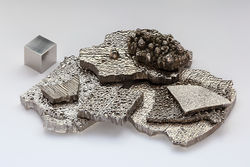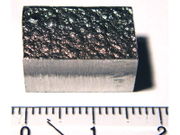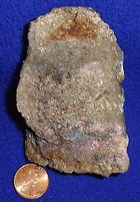Cobalt
|
|||||||||||||||||||||||||||||||||||||
| Appearance | |||||||||||||||||||||||||||||||||||||
|---|---|---|---|---|---|---|---|---|---|---|---|---|---|---|---|---|---|---|---|---|---|---|---|---|---|---|---|---|---|---|---|---|---|---|---|---|---|
hard lustrous gray metal |
|||||||||||||||||||||||||||||||||||||
| General properties | |||||||||||||||||||||||||||||||||||||
| Name, symbol, number | cobalt, Co, 27 | ||||||||||||||||||||||||||||||||||||
| Pronunciation | /ˈkoʊbɒlt/ KOH-bolt[1] | ||||||||||||||||||||||||||||||||||||
| Element category | transition metal | ||||||||||||||||||||||||||||||||||||
| Group, period, block | 9, 4, d | ||||||||||||||||||||||||||||||||||||
| Standard atomic weight | 58.933195g·mol−1 | ||||||||||||||||||||||||||||||||||||
| Electron configuration | [Ar] 4s2 3d7 | ||||||||||||||||||||||||||||||||||||
| Electrons per shell | 2, 8, 15, 2 (Image) | ||||||||||||||||||||||||||||||||||||
| Physical properties | |||||||||||||||||||||||||||||||||||||
| Color | metallic gray | ||||||||||||||||||||||||||||||||||||
| Density (near r.t.) | 8.90 g·cm−3 | ||||||||||||||||||||||||||||||||||||
| Liquid density at m.p. | 7.75 g·cm−3 | ||||||||||||||||||||||||||||||||||||
| Melting point | 1768 K, 1495 °C, 2723 °F | ||||||||||||||||||||||||||||||||||||
| Boiling point | 3200 K, 2927 °C, 5301 °F | ||||||||||||||||||||||||||||||||||||
| Heat of fusion | 16.06 kJ·mol−1 | ||||||||||||||||||||||||||||||||||||
| Heat of vaporization | 377 kJ·mol−1 | ||||||||||||||||||||||||||||||||||||
| Specific heat capacity | (25 °C) 24.81 J·mol−1·K−1 | ||||||||||||||||||||||||||||||||||||
| Vapor pressure | |||||||||||||||||||||||||||||||||||||
|
|||||||||||||||||||||||||||||||||||||
| Atomic properties | |||||||||||||||||||||||||||||||||||||
| Oxidation states | 5, 4 , 3, 2, 1, -1[2] (amphoteric oxide) |
||||||||||||||||||||||||||||||||||||
| Electronegativity | 1.88 (Pauling scale) | ||||||||||||||||||||||||||||||||||||
| Ionization energies (more) |
1st: 760.4 kJ·mol−1 | ||||||||||||||||||||||||||||||||||||
| 2nd: 1648 kJ·mol−1 | |||||||||||||||||||||||||||||||||||||
| 3rd: 3232 kJ·mol−1 | |||||||||||||||||||||||||||||||||||||
| Atomic radius | 125 pm | ||||||||||||||||||||||||||||||||||||
| Covalent radius | 126±3 (low spin), 150±7 (high spin) pm | ||||||||||||||||||||||||||||||||||||
| Miscellanea | |||||||||||||||||||||||||||||||||||||
| Crystal structure | hexagonal | ||||||||||||||||||||||||||||||||||||
| Magnetic ordering | ferromagnetic | ||||||||||||||||||||||||||||||||||||
| Electrical resistivity | (20 °C) 62.4 nΩ·m | ||||||||||||||||||||||||||||||||||||
| Thermal conductivity | (300 K) 100 W·m−1·K−1 | ||||||||||||||||||||||||||||||||||||
| Thermal expansion | (25 °C) 13.0 µm·m−1·K−1 | ||||||||||||||||||||||||||||||||||||
| Speed of sound (thin rod) | (20 °C) 4720 m/s | ||||||||||||||||||||||||||||||||||||
| Young's modulus | 209 GPa | ||||||||||||||||||||||||||||||||||||
| Shear modulus | 75 GPa | ||||||||||||||||||||||||||||||||||||
| Bulk modulus | 180 GPa | ||||||||||||||||||||||||||||||||||||
| Poisson ratio | 0.31 | ||||||||||||||||||||||||||||||||||||
| Mohs hardness | 5.0 | ||||||||||||||||||||||||||||||||||||
| Vickers hardness | 1043 MPa | ||||||||||||||||||||||||||||||||||||
| Brinell hardness | 700 MPa | ||||||||||||||||||||||||||||||||||||
| CAS registry number | 7440-48-4 | ||||||||||||||||||||||||||||||||||||
| Most stable isotopes | |||||||||||||||||||||||||||||||||||||
| Main article: Isotopes of cobalt | |||||||||||||||||||||||||||||||||||||
|
|||||||||||||||||||||||||||||||||||||
Cobalt (pronounced /ˈkəʊbɒlt/ KOH-balt)[3] is a hard, lustrous, gray metal, a chemical element with symbol Co and atomic number 27. Cobalt-based colors and pigments have been used since ancient times for jewelry and paints, and miners have long used the name kobold ore for some minerals.
Cobalt occurs in various metallic-lustered ores, for example cobaltite (CoAsS), but is mainly produced as a by-product of copper and nickel mining. The copper belt in the Democratic Republic of the Congo and Zambia yields most of the cobalt mined worldwide.
Cobalt is used in the preparation of magnetic, wear-resistant, and high-strength alloys. Smalte (cobalt silicate glass) and cobalt blue (cobalt(II) aluminate, CoAl2O4) gives a distinctive deep blue color to glass, ceramics, inks, paints, and varnishes. Cobalt-60 is a commercially important radioisotope, used as a tracer and in the production of gamma rays for industrial use.
Cobalt is an essential trace element for all animal organisms as the active center of coenzymes called cobalamins. These include vitamin B12 which is essential for mammals. Cobalt is also an active nutrient for bacteria, algae, and fungi.
Contents |
Characteristics

Cobalt is a ferromagnetic metal with a specific gravity of 8.9 (20°C). Pure cobalt is not found in nature, but compounds of cobalt are common. Small amounts of it are found in most rocks, soil, plants, and animals. It has the atomic number 27. The Curie temperature is 1115 °C, and the magnetic moment is 1.6–1.7 Bohr magnetons per atom. In nature, it is frequently associated with nickel, and both are characteristic minor components of meteoric iron. Mammals require small amounts of cobalt which is the basis of vitamin B12. Cobalt-60, an artificially produced radioactive isotope of cobalt, is an important radioactive tracer and cancer-treatment agent. Cobalt has a relative permeability two thirds that of iron. Metallic cobalt occurs as two crystallographic structures: hcp and fcc. The ideal transition temperature between hcp and fcc structures is 450 °C, but in practice, the energy difference is so small that random intergrowth of the two is common.[4]
Compounds
See also Category: Cobalt compounds Common oxidation states of cobalt include +2 and +3, although compounds with oxidation state +1 are also known. The most common oxidation state for simple compounds is +2; cobalt compounds in the +3 state are oxidizing agents. Cobalt(II) salts form the red-pink [Co(H2O)6]2+ complex in aqueous solution. Adding excess chloride will change the color from pink to blue, due to the formation of [CoCl4]2−.[2]
Oxygen and chalcogen compounds
Several oxides of cobalt are known. Green cobalt(II) oxide (CoO) has rocksalt structure. It is readily oxidized with water and oxygen to brown cobalt(III) hydroxide (CoO(OH)). At temperatures of 600–700 °C, CoO oxidizes to the blue cobalt(II,III) oxide (Co3O4), which has spinel structure.[2] Black cobalt(III) oxide (Co2O3) is also known.[5] Cobalt oxides are antiferromagnetic at low temperature: CoO (Neel temperature 291 K) and Co3O4 (Neel temperature: 40 K), which is analogous to magnetite (Fe3O4), with a mixture of +2 and +3 oxidation states.[6]
The principal chalcogenides of cobalt include the black cobalt(II) sulfides, CoS2, which adopts a pyrite-like structure, and Co2S3. Pentlandite (Co9S8) is metal-rich.[2]
Halides
-chloride-hexahydrate-sample.jpg)
The four dihalides of cobalt are known: cobalt(II) fluoride (CoF2, pink), cobalt(II) chloride (CoCl2, blue), cobalt(II) bromide (CoBr2, green), cobalt(II) iodide (CoI2, blue-black). These dihalides exist as anhydrous and hydrates. Whereas the anhydrous dichloride is blue, the hydrate is red.[7]
The reduction potential for the reaction
- Co3+ + e− → Co2+
is +1.92 V, far beyond the one for chlorine. As a consequence cobalt(III) fluoride is one of the few simple stable cobalt(III) compounds. Cobalt(III) fluoride, which is used in some fluorination reactions, reacts vigorously with water.[8]
Coordination compounds
As for all metals, molecular compounds of cobalt are classified as coordination complexes, i.e. molecules or ions that contain cobalt linked to several ligands. The ligands determine the oxidation state of the cobalt. For example Co+3 complexes tend to have amine ligands. Phosphine ligands tend to feature Co2+ and Co+, an example being tris(triphenylphosphine)cobalt(I) chloride ((P(C6H5)3)3CoCl). Oxide and fluoride can stabilize Co4+ derivatives, e.g. caesium hexafluorocobaltate (Cs2CoF6)) and potassium percobaltate (K3CoO4).[8]
Alfred Werner, a Nobel-prize winning pioneer in coordination chemistry, worked with compounds of empirical formula CoCl3(NH3)6. One of the isomers determined was cobalt(III) hexammine chloride. This coordination complex, a "typical" Werner-type complex, consists of a central cobalt atom coordinated by six ammine ligands orthogonal to each other, and three chloride counteranions.
Using chelating ethylenediamine ligands in place of ammonia gives tris(ethylenediamine)cobalt(III) chloride ([Co(en)3]Cl), which was one of the first coordination complexes that was resolved into optical isomers. The complex exists as both either right- or left-handed forms of a "three-bladed propeller." This complex was first isolated by Werner as yellow-gold needle-like crystals.[9]
Organometallic compounds
Cobaltocene is a highly stable cobalt analog to ferrocene. Cobalt carbonyl (Co2(CO)8) is a catalyst in carbonylation reactions. Vitamin B12 (see below) is a rare organometallic compound found in nature and is the only vitamin to contain a metal atom.
Creation
The stable form of cobalt is created in supernovas via the r-process
Isotopes
59Cobalt is the only stable cobalt isotope and the only isotope to exist in nature. 22 radioisotopes have been characterized with the most stable being 60Co with a half-life of 5.2714 years, 57Co with a half-life of 271.79 days, 56Co with a half-life of 77.27 days, and 58Co with a half-life of 70.86 days. All of the remaining radioactive isotopes have half-lives that are less than 18 hours, and the majority of these are less than 1 second. This element also has 4 meta states, all of which have half-lives less than 15 minutes.
The isotopes of cobalt range in atomic weight from 50 u (50Co) to 73 u (73Co). The primary decay mode for isotopes with atomic mass unit values less than that of the most abundant stable isotope, 59Co, is electron capture and the primary mode of decay for those of greater than 59 atomic mass units is beta decay. The primary decay products before 59Co are element 26 (iron) isotopes and the primary products after are element 28 (nickel) isotopes.
Cobalt radioisotopes in medicine
Cobalt-60 (Co-60 or 60Co) is a radioactive isotope of cobalt that is used in radiotherapy. It produces two gamma rays with energies of 1.17 MeV and 1.33 MeV. The 60Co source is about 2 cm in diameter and as a result produces a geometric penumbra, making the edge of the radiation field fuzzy. The metal has the unfortunate habit of producing a fine dust, causing problems with radiation protection. Cobalt-60 has a radioactive half-life of 5.27 years. This decrease in activity requires periodic replacement of the sources used in radiotherapy and is one reason why cobalt machines have been largely replaced by linear accelerators in modern radiation therapy. Cobalt from radiotherapy machines has been a serious hazard when not disposed of properly, and one of the worst radiation contamination accidents in North America occurred in 1984, after a discarded cobalt-60 containing radiotherapy unit was mistakenly disassembled in a junkyard in Juarez, Mexico.[10][11]
Cobalt-57 (Co-57 or 57Co) is a cobalt radioisotope most often used in medical tests, as a radiolabel for vitamin B12 uptake, and for the Schilling test.[12]
Industrial uses for radioactive isotopes
Cobalt-60 (Co-60 or 60Co) is useful as a gamma ray source because it can be produced in predictable quantity and high activity by simply exposing natural cobalt to neutrons in a reactor for a period. Its uses include sterilization of medical supplies and medical waste, radiation treatment of foods for sterilization (cold pasteurization), industrial radiography (e.g., weld integrity radiographs), density measurements (e.g., concrete density measurements), and tank fill height switches. Cobalt-57 is used as a source in Mössbauer spectroscopy and is one of several possible sources in XRF devices (Lead Paint Spectrum Analyzers).
Cobalt-60 as weapon
Nuclear weapon designs could intentionally incorporate 59Co, some of which would be activated in a nuclear explosion to produce 60Co. The 60Co, dispersed as nuclear fallout, creates what is sometimes called a cobalt bomb.[13]
History
Cobalt compounds have been used for centuries to impart a rich blue color to glass, glazes, and ceramics. Cobalt has been detected in Egyptian sculpture and Persian jewelry from the third millennium BC, in the ruins of Pompeii (destroyed AD 79), and in China dating from the Tang dynasty (AD 618–907) and the Ming dynasty (AD 1368–1644)[14]. Cobalt glass ingots have been recovered from the Uluburun shipwreck, dating to the late 14th century BC.[15]
Swedish chemist Georg Brandt (1694–1768) is credited with discovering cobalt circa 1735.[16][17] He was able to show that cobalt was the source of the blue color in glass, which previously had been attributed to the bismuth found with cobalt. The word cobalt is derived from the German kobalt, from kobold meaning "goblin", a term used for the ore of cobalt by miners. The first attempts at smelting the cobalt ores to produce cobalt metal failed, yielding cobalt(II) oxide instead. Also, because the primary ores of cobalt always contain arsenic, smelting the ore oxidized into the highly toxic and volatile arsenic oxide.
During the 19th century, cobalt blue was produced at the Norwegian Blaafarveværket (70–80% of world production), led by the Prussian industrialist Benjamin Wegner.
In 1938, John Livingood and Glenn T. Seaborg discovered cobalt-60. This isotope was famously used at Columbia University in the 1950s to establish parity violation in beta decay.
Occurrence
Cobalt occurs in copper and nickel minerals and in combination with sulfur and arsenic in the sulfidic cobaltite (CoAsS), safflorite (CoAs2) and skutterudite (CoAs3) minerals.[8] The mineral cattierite is similar to pyrite and occurs together vaesite in the copper deposits in the Katanga Province.[18] Upon contact with the atmosphere weathering the sulfide minerals oxidatize to pink erythrite ("cobalt glance": Co3(AsO4)2·8H2O) and sphaerocobaltite (CoCO3).
Production


Cobalt is not found as a native metal but is mainly obtained as a by-product of nickel and copper mining activities. The main ores of cobalt are cobaltite, erythrite, glaucodot, and skutterudite.[19][20]
In 2005, the copper deposits in the Katanga Province (former Shaba province) of the Democratic Republic of the Congo was the top producer of cobalt with almost 40% world share, reports the British Geological Survey.[21] The political situation in the Congo influences the price of cobalt significantly.[22]
Several methods exist for the separation of cobalt from copper and nickel. They depend on the concentration of cobalt and the exact composition of the used ore. One separation step involves froth flotation, in which surfactants bind to different ore components, leading to an enrichment of cobalt ores. Subsequent roasting converts the ores to the cobalt sulfate, whereas the copper and the iron are oxidized to the oxide. The leaching with water extracts the sulfate together with the arsenates. The residues are further leached with sulfuric acid yielding a solution of copper sulfate. Cobalt can also be leached from the slag of the copper smelter.[23]
The products of the above-mentioned processes are transformed into the cobalt oxide (Co3O4). This oxide is reduced to the metal by the aluminothermic reaction or reduction with carbon in a blast furnace.[8]
Applications
Alloys
Cobalt-based superalloys consume most of the produced cobalt. The temperature stability of these alloys makes them suitable for use in turbine blades for gas turbines and jet aircraft engines, though nickel-based single crystal alloys surpass them in this regard. Cobalt-based alloys are also corrosion and wear-resistant.[24] Special cobalt-chromium-molybdenum alloys are used for prosthetic parts such as hip and knee replacements.[25] Cobalt alloys are also used for dental prosthetics, where they are useful to avoid allergies to nickel.[26] Some high speed steels also use cobalt to increase heat and wear-resistance. The special alloys of aluminium, nickel, cobalt and iron, known as Alnico, and of samarium and cobalt (samarium-cobalt magnet) are used in permanent magnets.[27]
Batteries
Lithium cobalt oxide (LiCoO2) is widely used in lithium ion battery electrodes.[28] Nickel-cadmium [29] (NiCd) and nickel metal hydride[30] (NiMH) batteries also contain significant amounts of cobalt.
Catalysis
Several cobalt compounds are used in chemical reactions as oxidation catalysts. Cobalt acetate is used for the conversion of xylene to terephthalic acid, the precursor to the bulk polymer polyethylene terephthalate. Typical catalysts are the cobalt carboxylates (known as cobalt soaps). They are also used in paints, varnishes, and inks as "drying agents" through the oxidation of drying oils.[28] The same carboxylates are used to improve the adhesion of the steel to rubber in steel-belted radial tires.
Cobalt-based catalysts are also important in reactions involving carbon monoxide. Steam reforming, useful in hydrogen production, uses cobalt oxide-base catalysts. Cobalt is also a catalyst in the Fischer-Tropsch process, used in the conversion of carbon monoxide into liquid fuels.[31] The hydroformylation of alkenes often rely on cobalt octacarbonyl as the catalyst,[32] although such processes have been displaced by more efficient iridium- and rhodium-based catalysts, e.g. the Cativa process.
The hydrodesulfurization of petroleum uses a catalyst derived from cobalt and molybdenum. This process helps to rid petroleum of sulfur impurities that interfere with the refining of liquid fuels.[28]
Pigments and coloring

Before the 19th century, the predominant use of cobalt was as pigment. Since the Middle Ages, it has been involved in the production of smalt, a blue colored glass. Smalt is produced by melting a mixture of the roasted mineral smaltite, quartz and potassium carbonate, yielding a dark blue silicate glass which is ground after the production.[33] Smalt was widely used for the coloration of glass and as pigment for paintings.[34] In 1780 Sven Rinman discovered cobalt green and in 1802 Louis Jacques Thénard discovered cobalt blue.[35] The two colors cobalt blue, a cobalt aluminate, and cobalt green, a mixture of cobalt(II) oxide and zinc oxide, were used as pigments for paintings due to their superior stability.[36][37]
Cobalt has been used to color glass since the Bronze Age. The excavation of the Uluburun shipwreck yielded an ingot of blue glass which was cast during the 14th century BC.[38] Blue glass items from Egypt are colored with copper, iron, or cobalt. The oldest cobalt-colored glass was from the time of the Eighteenth dynasty in Egypt (1550–1292 BC). The location where the cobalt compounds were obtained is unknown.[39][40]
Other uses
- Electroplating due to its appearance, hardness, and resistance to oxidation.[41]
- Ground coats for porcelain enamels.[42]
Biological role

Cobalt is essential to all animals, including humans. It is a key constituent of cobalamin, also known as vitamin B12. A deficiency of cobalt leads to anemia, a lethal disorder. Anemia secondary to cobalt deficiency is very rare, though, because trace amounts of cobalt are available in most diets. The presence of 0.13 to 0.30 mg/kg of cobalt in soils markedly improves the health of grazing animals.
The cobalamin-based proteins use corrin to hold the cobalt. Coenzyme B12 features a reactive C-Co bond, which participates in its reactions.[43] In humans, B12 exists with two types of alkyl ligand: methyl and adenosyl. MeB12 promotes methyl (-CH3) group transfers. The adenosyl version of B12 catalyzes rearrangements in which a hydrogen atom is directly transferred between two adjacent atoms with concomitant exchange of the second substituent, X, which may be a carbon atom with substituents, an oxygen atom of an alcohol, or an amine. Methylmalonyl Coenzyme A mutase (MUT) converts MMl-CoA to Su-CoA, an important step in the extraction of energy from proteins and fats.
Although far less common than other metalloproteins (e.g. those of zinc and iron), cobaltoproteins are known aside from non-B12. These proteins include methionine aminopeptidase 2 and nitrile hydratase.[44]
Precautions
Cobalt is an essential element for life in minute amounts. The LD50 values soluble cobalt salts has been estimated to be between 150 and 500 mg/kg. Thus, for a 100 kg person the LD50 would be about 20 grams.[45]
After nickel and chromium, cobalt is a major cause of contact dermatitis and is considered carcinogenic.[46]
References
- ↑ Oxford English Dictionary, 2nd Edition 1989.
- ↑ 2.0 2.1 2.2 2.3 Greenwood, Norman N.; Earnshaw, Alan. (1997), Chemistry of the Elements (2nd ed.), Oxford: Butterworth-Heinemann, pp. 1117–1119, ISBN 0080379419
- ↑ Oxford English Dictionary, 2nd Edition 1989.
- ↑ "Properties and Facts for Cobalt". http://www.americanelements.com/co.html. Retrieved 2008-09-19.
- ↑ Robert E. Krebs (2006). The history and use of our earth's chemical elements: a reference guide (2 ed.). Greenwood Publishing Group. p. 107. ISBN 0313334382.
- ↑ . doi:10.1016/j.molcata.2007.08.023. http://digitalcommons.unl.edu/cgi/viewcontent.cgi?article=1021&context=chemistrylangell.
- ↑ Greenwood, Norman N.; Earnshaw, Alan. (1997), Chemistry of the Elements (2nd ed.), Oxford: Butterworth-Heinemann, pp. 1119–1120, ISBN 0080379419
- ↑ 8.0 8.1 8.2 8.3 Holleman, A. F., Wiberg, E., Wiberg, N. (2007). "Cobalt" (in German). Lehrbuch der Anorganischen Chemie, 102nd ed.. de Gruyter. pp. 1146–1152. ISBN 9783110177701.
- ↑ A. Werner (1912). "Zur Kenntnis des asymmetrischen Kobaltatoms. V". Chemische Berichte 45: 121–130. doi:10.1002/cber.19120450116.
- ↑ Blakeslee, Sandra (1984-05-01). "The Juarez accident". New York Times. http://query.nytimes.com/gst/fullpage.html?sec=health&res=9501E7D71338F932A35756C0A962948260. Retrieved 2009-06-06.
- ↑ "Ciudad Juarez orphaned source dispersal, 1983". Wm. Robert Johnston. 2005-11-23. http://www.johnstonsarchive.net/nuclear/radevents/1983MEX1.html. Retrieved 2009-10-24.
- ↑ "An overview of cobalt radioisotopes in medicine". http://www.helium.com/items/876792-an-overview-of-cobalt-radioisotopes-in-medicine. Retrieved 2009-06-06.
- ↑ Payne, L.R. (1977). "The Hazards of Cobalt". Occupational Medicine 27: 20–25. doi:10.1093/occmed/27.1.20. http://occmed.oxfordjournals.org/cgi/content/abstract/27/1/20.
- ↑ Encyclopedia Britannica Online.
- ↑ Pulak, Cemal (1998). "The Uluburun shipwreck: an overview". International Journal of Nautical Archaeology 27 (3): 188–224. doi:10.1111/j.1095-9270.1998.tb00803.x.
- ↑ Georg Brandt first showed cobalt to be a new metal in: G. Brandt (1735) "Dissertatio de semimetallis" (Dissertation on semi-metals), Acta Literaria et Scientiarum Sveciae (Journal of Swedish literature and sciences), vol. 4, pages 1–10.
See also: (1) G. Brandt (1746) "Rön och anmärkningar angäende en synnerlig färg — cobolt" (Observations and remarks concerning an extraordinary pigment — cobalt), Kongliga Svenska vetenskapsakademiens handlingar (Transactions of the Royal Swedish Academy of Science), vol.7, pages 119–130; (2) G. Brandt (1748) “Cobalti nova species examinata et descripta” (Cobalt, a new element examined and described), Acta Regiae Societatis Scientiarum Upsaliensis (Journal of the Royal Scientific Society of Uppsala), 1st series, vol. 3 , pages 33–41; (3) James L. Marshall and Virginia R. Marshall (Spring 2003) "Rediscovery of the Elements: Riddarhyttan, Sweden," The Hexagon (official journal of the Alpha Chi Sigma fraternity of chemists), vol. 94, no. 1, pages 3–8. - ↑ Wang, Shijie (2006). "Cobalt—Its recovery, recycling, and application". Journal of the Minerals, Metals and Materials Society 58 (10): 47–50. doi:10.1007/s11837-006-0201-y.
- ↑ Kerr, Paul F. (1945). "Cattierite and Vaesite: New Co-Ni Minerals from the Belgian Kongo". American Mineralogist 30: 483–492. http://www.minsocam.org/ammin/AM30/AM30_483.pdf.
- ↑ Shedd, Kim B.. "Mineral Yearbook 2006: Cobalt". United States Geological Survey. http://minerals.usgs.gov/minerals/pubs/commodity/cobalt/myb1-2006-cobal.pdf. Retrieved 2008-10-26.
- ↑ Shedd, Kim B.. "Commodity Report 2008: Cobalt". United States Geological Survey. http://minerals.usgs.gov/minerals/pubs/commodity/cobalt/mcs-2008-cobal.pdf. Retrieved 2008-10-26.
- ↑ "African Mineral Production". British Geological Survey. http://www.bgs.ac.uk/mineralsuk/downloads/african_mp_01_05.pdf. Retrieved 2009-06-06.
- ↑ Wellmer, Friedrich-Wilhelm; Becker-Platen, Jens Dieter. "Global Nonfuel Mineral Resources and Sustainability". http://pubs.usgs.gov/circ/2007/1294/paper1.html. Retrieved 2009-05-16.
- ↑ Joseph R. Davis (2000). ASM specialty handbook: nickel, cobalt, and their alloys. ASM International. p. 347. ISBN 0871706857. http://books.google.com/?id=IePhmnbmRWkC&dq=cobalt+copper+nickel+ore+separate.
- ↑ Donachie, Matthew J. (2002). Superalloys: A Technical Guide. ASM International. ISBN 9780871707499. http://books.google.com/?id=vjCJ5pI1QpkC.
- ↑ Michel, R.; Nolte, M.; Reich M.; Löer, F. (1991). "Systemic effects of implanted prostheses made of cobalt-chromium alloys". Archives of Orthopaedic and Trauma Surgery 110 (2): 61–74. doi:10.1007/BF00393876. PMID 2015136.
- ↑ Disegi, John A. (1999). Cobalt-base Aloys for Biomedical Applications. ASTM International. p. 34. ISBN 0803126085. http://books.google.com/?id=z4rXM1EnPugC.
- ↑ Luborsky, F. E.; Mendelsohn, L. I.; Paine, T. O. (1957). "Reproducing the Properties of Alnico Permanent Magnet Alloys with Elongated Single-Domain Cobalt-Iron Particles". Journal Applied Physics 28 (344): 344. doi:10.1063/1.1722744.
- ↑ 28.0 28.1 28.2 Hawkins, M. (2001). "Why we need cobalt". Applied Earth Science: Transactions of the Institution of Mining & Metallurgy, Section B 110 (2): 66–71.
- ↑ . doi:10.1007/BF01009266.
- ↑ . doi:10.1016/S0378-7753(98)00182-7.
- ↑ Andrei Y. Khodakov, Wei Chu, and Pascal Fongarland “Advances in the Development of Novel Cobalt Fischer-Tropsch Catalysts for Synthesis of Long-Chain Hydrocarbons and Clean Fuels” Chemical Review, 2007, volume 107, pp 1692–1744. doi:10.1021/cr050972v
- ↑ Frdric Hebrard and Philippe Kalck “Cobalt-Catalyzed Hydroformylation of Alkenes: Generation and Recycling of the Carbonyl Species, and Catalytic Cycle” Chemical Reviews, 2009, volume 109, pp 4272–4282. doi:10.1021/cr8002533
- ↑ Overman, Frederick (1852). A treatise on metallurgy. D. Appleton & company. pp. 631–637. http://books.google.com/?id=APgQAAAAIAAJ&pg=PA631.
- ↑ Muhlethaler, Bruno; Thissen, Jean (1969). "Smalt". Studies in Conservation 14 (2): 47–61. doi:10.2307/1505347. http://www.jstor.org/stable/1505347.
- ↑ Gehlen, A.F. (1803). "Ueber die Bereitung einer blauen Farbe aus Kobalt, die eben so schön ist wie Ultramarin. Vom Bürger Thenard". Neues allgemeines Journal der Chemie, Band 2 (H. Frölich.). http://books.google.com/?id=UGsMAQAAIAAJ&pg=RA1-PA506. (German translation from L. J. Thénard; Journal des Mines; Brumaire 12 1802; p 128-136
- ↑ Witteveen, H. J.; Farnau, E. F. (1921). "Colors Developed by Cobalt Oxides". Industrial & Engineering Chemistry 13: 1061. doi:10.1021/ie50143a048.
- ↑ Venetskii, S. (1970). "The charge of the guns of peace". Metallurgist 14 (5): 334–336. doi:10.1007/BF00739447.
- ↑ Henderson, Julian (2000). "Glass". The Science and Archaeology of Materials: An Investigation of Inorganic Materials. Routledge. p. 60. ISBN 9780415199339. http://books.google.com/?id=p9xJ-VpUuNkC.
- ↑ Rehren, Th. (2003). "Aspects of the Production of Cobalt-blue Glass in Egypt". Archaeometry 43 (4): 483–489. doi:10.1111/1475-4754.00031.
- ↑ Lucas, A. (2003). Ancient Egyptian Materials and Industries. Kessinger Publishing. p. 217. ISBN 9780766151413. http://books.google.com/?id=GugkliLHDMoC.
- ↑ "Cobalt". p. 354. http://books.google.de/books?id=IePhmnbmRWkC&pg=PA354.
- ↑ "Ground–Coat Frit". p. 129. http://books.google.de/books?id=-CIrAAAAYAAJ&pg=PA129.
- ↑ Voet, Judith G.; Voet, Donald (1995). Biochemistry. New York: J. Wiley & Sons. p. 675. ISBN 0-471-58651-X. OCLC 31819701.
- ↑ Kobayashi, Michihiko; Shimizu, Sakayu (1999). "Cobalt proteins". European Journal of Biochemistry 261 (1): 1–9. doi:10.1046/j.1432-1327.1999.00186.x. PMID 10103026.
- ↑ John D. Donaldson, Detmar Beyersmann "Cobalt and Cobalt Compounds" in Ullmann's Encyclopedia of Industrial Chemistry 2005, Wiley-VCH, Weinheim. doi:10.1002/14356007.a07_281.pub2
- ↑ Basketter, David A.; Angelini, Gianni; Ingber, Arieh; Kern, Petra S.; Menné, Torkil (2003). "Nickel, chromium and cobalt in consumer products: revisiting safe levels in the new millennium". Contact Dermatitis 49 (1): 1–7. doi:10.1111/j.0105-1873.2003.00149.x. PMID 14641113.
External links
- National Pollutant Inventory – Cobalt fact sheet
- WebElements.com – Cobalt
- London celebrates 50 years of Cobalt-60 Radiotherapy
| H | He | ||||||||||||||||||||||||||||||||||||||||
| Li | Be | B | C | N | O | F | Ne | ||||||||||||||||||||||||||||||||||
| Na | Mg | Al | Si | P | S | Cl | Ar | ||||||||||||||||||||||||||||||||||
| K | Ca | Sc | Ti | V | Cr | Mn | Fe | Co | Ni | Cu | Zn | Ga | Ge | As | Se | Br | Kr | ||||||||||||||||||||||||
| Rb | Sr | Y | Zr | Nb | Mo | Tc | Ru | Rh | Pd | Ag | Cd | In | Sn | Sb | Te | I | Xe | ||||||||||||||||||||||||
| Cs | Ba | La | Ce | Pr | Nd | Pm | Sm | Eu | Gd | Tb | Dy | Ho | Er | Tm | Yb | Lu | Hf | Ta | W | Re | Os | Ir | Pt | Au | Hg | Tl | Pb | Bi | Po | At | Rn | ||||||||||
| Fr | Ra | Ac | Th | Pa | U | Np | Pu | Am | Cm | Bk | Cf | Es | Fm | Md | No | Lr | Rf | Db | Sg | Bh | Hs | Mt | Ds | Rg | Cn | Uut | Uuq | Uup | Uuh | Uus | Uuo | ||||||||||
|
|||||||||||||||||||||||||||||||||||||||||
|
|||||||||||||||||||||||||||||||||||||||||
|
|||||